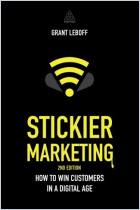Join getAbstract to access the summary!

Join getAbstract to access the summary!
Grant Leboff
Sticky Marketing
Why Everything in Marketing Has Changed and What to Do about It
Kogan Page, 2011
What's inside?
If you earned your degree in marketing more than five years ago, you need to read this book.
Recommendation
As the subtitle of this book states, “everything in marketing has changed.” Marketers should no longer concern themselves with the previously undisputed principles of unique selling propositions (USPs), client benefits, positioning, local competition and even superior service. Social networks have redistributed power into the hands of the consumer. Now, to make your brand attractive, you must take the focus off the transaction and provide value, create an experience and join in the online conversation. Grant Leboff thoughtfully outlines the new, “sticky” method of marketing, explaining why “customer engagement” reigns supreme. He lays out the ABCs of “sticky marketing,” including helpful summaries at the conclusions of each chapter. getAbstract recommends that all marketers give this a thorough read and refer to it often.
Summary
About the Author
Grant Leboff wrote the bestseller Sales Therapy. He is on the advisory council of The Global Marketing Network and has contributed articles to the Daily Telegraph, The Independent and the Financial Times,



















Comment on this summary